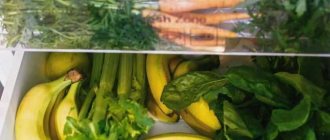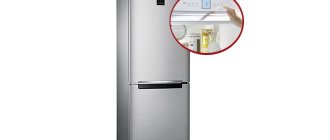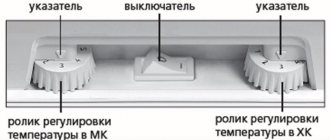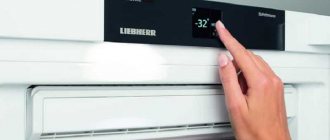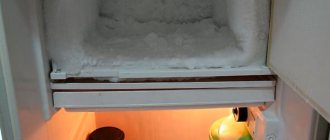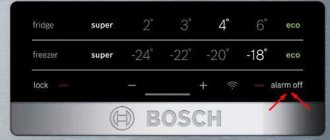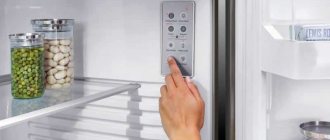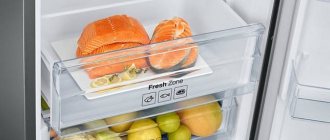Basic principles
What temperature should be in the refrigerator and freezer:
- The ideal overall refrigerator temperature should be between +3 and +5°C.
- The freezer must maintain a temperature of -18° C or lower.
- In the freshness zone (if there is one), set the temperature to about 0-1° C.
After adjusting the thermostat, the desired climate will be established in 6-8 hours
These standards are suitable for storing most products, but still not for all - some supplies need to be stored at zero temperature, while others need to be stored at 5-10 degrees Celsius. Moreover, in different zones of the chamber the cold is distributed differently, despite the given general mode. Somewhere the climate is warmer, and somewhere noticeably colder.
- So it turns out that even after adjusting the thermostat correctly, we can find milk with ice in the refrigerator, unexpectedly rotten eggs or lettuce leaves that for some reason have turned into a jelly-like slurry.
Of course, the average consumer does not need to know the intricacies of storage conditions for all types of products, but there are some recommendations that are not difficult to remember and apply in life. Our little guide will help you with this in the next section of the article.
Temperature norm and its meaning
A refrigerator is a necessary attribute in every family. It helps keep foods fresh, safe and healthy, and cool drinks. Not everyone thinks about the question of what temperature should be in the refrigerator and what this affects.
A correctly adjusted operating mode is necessary for:
- food safety;
- preventing the occurrence of unpleasant odors;
- reducing electricity consumption;
- increasing the time interval between defrosting the freezer;
- increasing the service life of equipment.
There is no clear answer to the question of what the optimal temperature in the refrigerator and freezer should be. This indicator varies significantly in different areas of the refrigerator compartment. It is necessary to take into account the range of products that are stored there; usually it ranges from – 2 to + 5°C.
If we are talking about a freezer, before choosing a mode, you need to determine whether a lot of food is stored in it, how often you open it, and whether you use the “quick freezing” function.
Optimal temperature in a home refrigerator
Relatively recently, the temperature in the refrigerator directly depended on the weather outside. In winter, its role was played by a balcony, in summer - by a cellar, if you were lucky enough to have one. Fortunately, John Gorey invented a way to make artificial ice, and by the middle of the 19th century a refrigerator was invented. True, a household refrigerator powered by electricity was released only in the 13th year of the last century. But we don’t have a historical reference, but an educational article, so let’s move on to the point.
How many degrees should the temperature be in a home refrigerator? +2 - +4 in the refrigerator and -18 degrees in the freezer are considered optimal. True, not everything is so simple. After all, many have heard that eggs should be stored on the door, vegetables in the bottom drawers, and, say, yesterday's soup on the top shelf. Many people wonder why this is so?
The fact is that, having set the temperature on the device, no one can guarantee that it is now clearly +5 degrees. This is all due to different cold zones and physical laws of air circulation. If the freezer is located at the bottom, as in most modern refrigerators, the bottom shelves will be the coldest, and vice versa.
Important! The closer the shelf is to the freezer, the lower the temperature there.
Average and normal temperature
The question of temperatures is not as simple as it seems. The fact is that the operation of a refrigeration unit is influenced by many factors. The two most important are:
- Temperature outside the refrigerator. It depends on the time of year and the climatic characteristics of the region in which the refrigerator is operated. The higher the outside temperature, the more heat enters the chamber each time the door is opened.
- Refrigerator load level. If the amount of supplies is too large or small, the load on the compressor increases and it becomes more difficult to maintain the optimal temperature.
If the refrigerator is empty, place a few bottles of water on the shelves. This will make the compressor work easier, since water accumulates cold well.
Manufacturers' approaches to determining the optimal temperature also vary. Thus, a large manufacturer of refrigeration equipment BOSCH indicates in the instruction manual that the normal temperature in the main compartment is +4°C, in the freezer - -18°C. Other manufacturers may use different calculation methods and provide different figures.
The numbers given represent the average temperature. This can be achieved with optimal loading, and the door should not be opened for a long time. During this time, the temperature in all sections of the refrigeration chamber will equalize. But as soon as you open the door, a flow of warm air from the room will go inside the device, making the air in the part of the chamber closest to the room warmer.
Normal temperature is the value at which food stored in the refrigerator will not spoil for the longest possible time. Experts call normal temperatures ranging from +2° C to +4°C.
Distribution of cold zones in the refrigerator
Temperature fluctuations on the shelves depend on the location of the freezer. Next we will look at an example with a camera from below. If you have it on top, then all zones will be located the other way around, except for the so-called freshness zone. This is the penultimate shelf on the bottom of the cooling compartment. In modern models, the manufacturer places a special compartment there, calling it Fresh Box.
Another nuance is the shelves on the device door. Due to constant contact with the air in the room, and the more often you open the refrigerator, the more contact there is, the temperature there increases significantly. The indicator starts at +5 Celsius and can reach +10 degrees. This is important to consider when choosing products for this area.
Advice! Due to the location of the door on the side, cold air does not circulate there as actively. Therefore, it is better not to store perishable foods here. The best option is eggs, sauces, drinks.
Below are the products and their corresponding zones. But in fact, be sure to read the label, which clearly indicates storage conditions. With the temperature set on the device at +4, you will get approximately:
- 0 - +3 degrees on the bottom shelf - suitable for storing fresh meat, fish and dairy products;
- +3 - +4 in Fresh box - ideal for fresh vegetables, fruits and herbs;
- + 4 in the freshness zone – optimal for ready-made dishes, sausages or smoked meats;
- +4 - +6 on the top shelf - it’s good to defrost food here and store some ready-made dishes for 1-2 days.
Reference! If you do not have a Fresh box, then vegetables and fruits will be stored in special drawers at the bottom of the compartment. If the box is available, store ready-made dishes on the shelf above it - this will be the freshness zone.
These are average figures with a moderate opening of the device. If you do not touch it for 10–12 hours, the indicator will level out to the set +4 degrees Celsius - the optimal mode of operation of the device, in which it will last you longer, and the products will not deteriorate quickly. If you set the temperature higher, it will shorten the life of the device and cost you a pretty penny due to higher electricity consumption. If you set less, wanting to save money or preserve your equipment as much as possible, then you can pay with your health, because the products will spoil faster.
Types of cooling systems
The most important part of any refrigerator is the cooling system. Depending on the design and operating principle, cooling systems are divided into compressor, absorption and thermoelectric. Let's talk in more detail about each type.
Compressor
This is the most common type, most often found in home appliances. It is distinguished by economy and efficiency. In compression cooling systems, the circulation of refrigerant is carried out through the operation of a compressor, when pumped into which the coolant is compressed.
Most refrigerators are equipped with one compressor, which is responsible for the temperature in both the refrigerator compartment and the freezer. But there are also two-compressor models with two cooling circuits. Such a device allows, if necessary, to turn off one of the cameras and set a certain temperature regime in it.
A significant disadvantage of devices with two compressors is their high price. Such devices do not have a No Frost system that controls the defrosting process to avoid ice accumulation.
Manufacturers of household appliances produce single-compressor models with a dual-circuit cooling system. It involves the presence of several evaporators and a special control system responsible for selective direction of refrigerant movement.
Absorption
The cold in the system is generated by the circulation and evaporation of refrigerant dissolved in the liquid. This type of device is not often found in a typical apartment. It is usually installed where there is no constant power supply.
Important! The advantage of an absorption device is the use of alternative energy sources and the absence of noise during operation.
Depending on the type of energy source, absorption refrigerators are divided into four types:
- Electric - powered by electricity.
- Gas - using energy from the combustion of liquefied gas. The most economical type of device. One 5 liter gas cylinder is enough for an average of 230 hours of continuous operation.
- Kerosene - kerosene is used to produce energy.
- Combined - gas and electricity.
Thermoelectric
In such a cooling system, the temperature decrease is carried out according to the principle of direct heat absorption. No refrigerant is used. Coolers are semiconductor wafers through which electric current passes. As a result, the inside of the element cools and the outside heats up. When the direction of the current changes, the processes occur in the reverse order.
Thermoelectric systems are used mainly in small-sized models. Their use in large-volume refrigerators is irrational due to increased energy consumption.
Average refrigerator temperature
Household refrigerators have a range of operating temperatures. The maximum ranges from +5 to +8 degrees, the minimum from 0 to +3 °C. If you wish, you can set any one. The optimal refrigerator temperature depends on what foods are stored in the refrigerator and how often the door is opened.
The ideal temperature in the refrigerator is +2…+4 degrees. When the door is opened frequently, warm air enters the chamber. In this case, reduce the temperature by 1 degree. Accordingly, set within +1…+3 °С.
There are colder and warmer areas in the refrigerator compartment. Minimum difference in refrigerators with the No Frost system. The maximum is in units with a drip system. You can read more about their differences in the article about the operating principle of the No Frost system.
Signs of malfunctions and their prevention
The appearance of one of the following symptoms indicates a malfunction in the operation of the household appliance:
- snow and ice accumulate on the walls faster than usual;
- the device is too noisy or, conversely, quieter than usual;
- frozen food is covered in condensation or puddles of water have formed inside the appliance.
If at least one of these signs is detected, then the freezer needs repair.
Timely prevention will help you avoid troubles:
- Once every six months, unplug the camera and completely defrost it. After defrosting, wash and dry the device. This rule also applies to refrigerators with a No Frost system (they are defrosted once a year).
- Check the serviceability of the rubber seals on the doors. Their wear leads to insufficiently tight closing of the doors, an increase in the temperature inside the chamber and the formation of condensation.
- Avoid overloading the device with products and their uneven distribution inside the chamber. Fill the freezer so that there is free space inside.
What temperature should the freezer be?
It's not so simple with the freezer either. After reading the instructions carefully, you can find out that it is also divided into conditional zones, and the required temperature may change in different situations. For example, proper freezing requires one indicator, and storage requires another. The higher the degree, the shorter the frozen shelf life. A key role when choosing the temperature in the freezer is played by its load.
If the load is average, you can get by with the optimal -18 Celsius, if it’s minimal, then -14 is enough. But for those who actively prepare food, especially meat and fish, and pack the freezer compartment tightly, it makes sense to lower the indicator to minus 20-22. Not wanting to use a lot of electricity, you can set it to -18 in such a situation, but only after all the food is well frozen.
If you want to quickly freeze a product, set the lowest temperature; in different devices it fluctuates around minus 26-30 degrees Celsius.
Features of temperature conditions
Refrigerated household appliances have different capabilities for storing food. They are determined by the temperature conditions in the freezer. Detailed information about this is contained in the instructions for the device.
What temperature should the freezer be:
- –6°С. This mode is intended for storing refrigerated and frozen food for no more than 30 days. The already frozen product is placed in the freezer. It is not recommended to store fish and plant foods (fruits, vegetables, berries, legumes) at this temperature for a long time.
- –12°С. In such conditions, products are stored for up to 3 months, provided that they were previously frozen and stored at a constant temperature (without defrosting). Not recommended for long-term storage of fatty fish and plant products.
- –18°С. At this temperature, any type of food can be stored for up to a year.
Accurate temperature control is especially important during long-term storage. Even a short-term increase in indicators leads to a reduction in its terms. For this reason, in modern freezers, manufacturers have provided 2 modes: for storage and freezing.
In storage mode, values close to –18°C are maintained, while in freezing mode – about –24°C, so that the product quickly freezes to its full depth.
Minimum temperatures are achieved with continuous operation of the compressor. The duration of the freezing mode is up to 24 hours. After completion, the freezer automatically switches to cyclic storage mode at –18°C.
Attention! Prolonged operation of the compressor without switching off leads to rapid wear of parts and increased energy consumption.
To make freezing faster, the thickness of the slices or briquettes should not exceed the recommended values for each type of product. Rapid freezing ensures maximum preservation of product quality for a long time.
How to check temperature
Some refrigerators and freezers have an external or internal sensor that accurately displays the temperature in the compartments. However, many devices do not have such a sensor, in which case the temperature must be measured independently with a refrigerator thermometer. Here's how to do it:
- In the refrigerator: Place the thermometer in a glass of water and leave it on the middle shelf for at least 8 hours or overnight. The door must remain closed at all times.
- In the freezer: place the thermometer between two bags of food and leave for 8 hours.
Refrigerator thermometer.
How to measure and regulate cold levels
The ability to adjust the refrigerator temperature depends on the device used. For owners of modern appliances, this task is completely solvable - usually the temperature in the refrigerator and freezer can be adjusted using electronic or mechanical controls. There are models with an unregulated operating mode; these can be office devices or small-sized devices.
To know exactly how well the selected operating mode of the equipment meets expectations, you need to have an idea of the level of cold. Some modern devices are equipped with indicators that display the temperature distribution in various compartments. Much more often, you can control the temperature only with a thermometer. Let's consider various options for adjusting and controlling the cold level.
With electronic system
Many modern models are equipped with an electronic control system. This system allows you to set the desired temperature parameters. In addition, the control panel often displays the current temperature in the refrigerator. The control panel may be located on the outer surface of the refrigeration equipment, or may be covered by a door. The controls can be touch or push-button, making it easy to set everything up. Electronic control is the most user-friendly system. With its help, it is very easy to establish what temperature should be in the Indesit refrigerator or in any other refrigerator equipped with a similar control system.
With mechanics
Budget models are usually equipped with a Mexican control system. In this case, the control elements are located inside the device. The optimal operating mode often has to be established experimentally, starting from the minimum or maximum value of the compressor power. So, for example, the temperature in the Atlant refrigerator is regulated by a wheel switch located inside the refrigerator compartment. The required parameters are set by rotating this wheel.
To find out whether the set mode of operation meets expectations, you will need a thermometer. It is recommended to place the thermometer in a glass of water and place this glass on the middle shelf of the refrigerator. To ensure maximum measurement accuracy, it is advisable not to open the door for 12 hours (however, it is widely believed that 8 hours is enough for this). If the temperature regime after such a measurement turns out to be non-optimal, you will have to adjust it again using the switch and measure the cold level again.
With separate settings
In devices with separate temperature settings, there are two regulators, separately for the freezer and refrigerator compartment. Controls can be electronic or mechanical, such as temperature controllers in Atlant refrigerators. Apart from the possibility of separately adjusting the operating modes of refrigeration equipment, such a system does not have any other features.
How to measure the temperature in the freezer
Before measuring the temperature in the freezer, check the instructions for your refrigerator model. See what minimum temperature it can produce. Subtract 10 from the value. You will need a thermometer with this minimum scale.
For example, your freezer can cool down to -24. This means you will need a thermometer that can measure down to -34 degrees Celsius. These precautions are needed in case the freezer is not working properly.
If the refrigerator was not turned on, start it. Place the thermometer on the bottom shelf of the freezer. After an hour, measure your temperature.
If the refrigerator was turned on and the freezer was running, place the thermometer on the bottom shelf between the items. After 20 minutes of operation, you can check the temperature.
Does the freezer operate at subzero temperatures?
It’s minus outside, the liquid turns into ice not only in the compressor. You managed to harden the thermal relay, it turns on the system. Will the freezer work at sub-zero temperatures?
- The lubricant in the system becomes thick, friction resistance increases, and overload protection is triggered.
- Not all of the freon boils, the compressor compresses the gas and liquid mixture, and the liquid has a different resistance to compression.
- No Frost does not work in the cold, the evaporator becomes overgrown with ice.
- In the cold, seals lose their elasticity and depressurization occurs.
All of the above is confirmed by the fact that working at sub-zero temperatures, the freezer quickly collapses. When leaving an idle freezer in an unheated room for the winter, you should dry it well and open the door slightly to ventilate the chamber.
How to set the temperature in the refrigerator
All refrigerator models have one of two ways to regulate the temperature in the chamber: electronic and mechanical. In the first case, there is a display on or above the main compartment door. You can set the exact temperature using keys or touch controls.
The mechanical version is more difficult. To set the temperature in the refrigerator there is a round regulator. It is located in the chamber near the light bulb or outside above the sash. There is a scale on it or nearby. Usually it has from 5 to 9 values. The higher the number, the more the chamber cools.
Mechanical temperature regulator in the main chamber of the refrigerator near the lamp. The numbers on the scale do not correspond to the temperature in degrees. Therefore, in order to install it in the refrigerator accurately, you will have to remember the mathematics. You also need to read the instructions or specifications for the refrigerator.
First you need to find within what limits the refrigerator operates. For example, your model has a range from +2 to +6 °C. We calculate the difference between them and get a value of 4 degrees. After this, count the number of spaces between the scale divisions. In the photo above there are 9 divisions and 8 spaces (we also count Min and Max).
Then divide the temperature range by the number of intervals. In our case, divide 4 by 8 and get 0.5. This number is the number of degrees by which the temperature rises or falls when the dial is turned 1 notch. Now you know how to set the temperature in the refrigerator.
How to adjust the temperature
The temperature in the refrigerator is set strictly according to the instructions. After turning on the new device, it is set to standard temperatures. Set the required mode in the household appliance manually.
There are two types of regulators:
- Mechanical - is a rotary disk, which is located at the top or right on the inner body of the refrigerator. It is adjusted by turning clockwise. This provides an increase in the flow of cooler air.
- Electronic - is a display that is located on the outer surface of the device or inside the chamber. To change settings, use the buttons on the controller.
Reasons why the thermostat is adjusted:
- food in the main chamber freezes or quickly deteriorates;
- Ice melts in the freezer;
- snow or ice deposits form on the walls of the refrigerator;
- The device consumes a lot of electricity.
Electronically controlled
You can set the temperature on an electronically controlled refrigerator on a special display. Most often, manufacturers install it at the top of the device under the freezer. You can adjust the indicators using the arrows. If the model is equipped with a keyboard, you just need to enter the required parameters. Once the temperature is set, you need to check it with a thermometer. This procedure is recommended even in devices with a built-in temperature sensor.
With mechanical control
The temperature of a mechanically controlled refrigerator is controlled by a switch, which is usually located at the top of the cabinet or inside the refrigerator compartment. Depending on the manufacturer and model, it may have a different shape. To set the required indicator, you need to turn the knob or move the switch to the desired position. The positions of the regulator in different models are marked differently: from 0 to 7, from Min to Max, etc.
To increase the temperature, you need to turn the knob or move the slider to the right, and to lower it, to the left. After 6-8 hours, it is recommended to check the temperature in the chamber using a thermometer. If they do not meet the requirements, a correction is made. This is done until the temperature reaches the desired temperature. It is recommended to mark the optimal switch position with a marker.
Temperature standard
Depending on the load level of the freezer and the model of home refrigeration equipment, the required temperature is set.
After all, the more products in the freezer, the more energy is required to maintain their freshness by lowering the temperature and creating the necessary conditions.
How many degrees should be in the freezer is usually written down in the documents for the refrigerator. The normal indicator is the range from -25°C to -16°C.
If the product load is very small, then the temperature can be increased to the range from -18°C to -14°C. This way you can maintain the desired microclimate inside the freezer, ensuring the freshness of food, and reduce energy costs.
Important! When storing berries, vegetable products, semi-finished fish and meat products, the products must be frozen as quickly as possible. Then you will need to set a lower temperature: set to -30°C for several hours.
Methods of regulation on different models of refrigerators
Setting the temperature regime of the device depends on its design and technical features. In modern models, the temperature regime is regulated separately inside the refrigerator compartment and in the freezer.
It is possible to adjust the individual compartments independently of each other. If the refrigerator is single-chamber, then the temperature is set on one regulator. Let's look at how to set up a refrigerator depending on the model.
- Atlant. The device has two mechanical thermostats with numbers, where 1 is the highest temperature, 7 is the lowest. At 0 the compressor is turned off. The relays scroll clockwise.
- Bosch . Equipped with electronic control. They press a button on the display and wait for the desired temperature to appear. If the temperature in the refrigerator compartment is lowered, the same happens in the freezer. The optimal temperature for the main chamber in the refrigerator is +4°C.
- Beko. The device has a mechanical regulator, the maximum value is 5. For optimal operation, it is set to the average value - 3. The optimal temperature of the refrigerator compartment is +5°C. To avoid putting too much stress on the thermostat, do not place hot food in the refrigerator.
- Daewoo. The equipment is equipped with electronic control. The display is installed on the outer surface of the freezer. The device selects one of four temperature modes:
- minimum indicator (min);
- average (med);
- maximum value (max);
- automatic indicator, which is set when the ambient temperature is less than +10°C (super).
According to the instructions, press the Temp button on the display and select the desired mode by successive pressings. To set the Fuzzy Control mode, press the Fuzzy button on the display. In this mode, automatic control over the operation of the device is carried out.
There is an additional regulator in the freezer that ensures the flow of cold air into the main chamber. It also has four modes:
- minimum (min);
- average (med);
- maximum (max);
- automatic indicator, which is set when the ambient temperature is less than +10°C (winter).
When set to the minimum setting, the maximum flow of cold air enters the refrigerator compartment. The optimal value for the device is medium mode (med).
- Gorenje. A mechanical thermostat is installed. The mode is selected by turning the knob from the Min to Max position. The manufacturer's recommended position is ECO.
- Indesit. The device is equipped with a mechanical regulator indicating numbers from 1 to 5. They indicate the temperature mode, where the warmest is 1, the coldest is 5. In some models there is no numerical designation on the thermostat. To raise or lower the temperature, tilt the handle. The more it is turned, the greater the flow of cold air into the refrigerator.
- LG. Older models are equipped with mechanical regulators on which modes are selected:
- minimum (min);
- average (med);
- maximum (max).
The modern device has electronic control with separate gearboxes for the compartments. They also have a function that adjusts the degrees in the Fresh Converter compartment.
- North. Nord refrigerators have a mechanical handle with 3 active modes. The thermostat for different models is installed inside or outside the case.
- Samsung. Samsung refrigerators have a sensor installed. The user sets different temperatures for the freezer and refrigerator compartments. For the freezer - in the range of minus 14-24.
For the main camera - in the range of plus 1−7. Samsung users can use accelerated freezing. This feature runs for 72 hours and turns off automatically.
- Sharp. The Sharp refrigerator has a panel for setting the mode. The freezing intensity is set by the position of the handle or buttons. Unlike other brands, Sharp equipment has a screen next to the handle. The screen shows how many degrees the scale division represents.
- Stinol. Stinol refrigerators have two independent thermostats. The range of each is from 1 to 5. Super cool function for freezer is available. There is a sensor that signals if the cooling is too intense.
Setting optimal parameters.
- Zanussi. The Zanussi company produces units with different thermostat designs. For different models, you can set the mode using a rotary knob, switch or sensor.
- Biryusa . Biryusa refrigerators have a rotary knob to control the mode. You have to adjust the mode with the door open, since the handle is installed inside.
- Ariston. Ariston refrigerators have a knob for adjusting the mode. Unlike the previous line, Ariston models have 5 divisions on the scale.
What level of cold is desirable?
Opinions about what temperature is optimal in the refrigerator and freezer are quite contradictory. This is due to the fact that the optimal temperature for storing a variety of products is different temperatures both in the refrigerator and in the freezer. However, there are standard recommendations for food storage conditions. By following these recommendations, you can increase the shelf life of products, as well as preserve their taste to the maximum extent.
Optimal for the main part
Our service center offers its services for repairing household appliances at a competitive price. We repair any breakdowns of modern household appliances. Leave a request and get a 15% discount - Leave a request
Let's figure out how many degrees the refrigerator should be and what the correct temperature should be set in it if it is possible to adjust the temperature regime. Different products have their own optimal temperature ranges in which the storage process is most effective. Thus, fresh meat is well stored in the range from +1 °C to +3 °C, and fish is already stored from 0 °C to +2 °C. Eggs are usually stored on a special shelf installed in the door, but there the temperature reaches +10 °C, and the optimal range for eggs is considered to be from +2 °C to +5 °C.
As you can see, the desired temperature ranges for various products overlap, so a certain average value of this indicator was derived, which is suitable for storing most perishable products - the temperature in the refrigerator should be from +2 °C to +4 °C.
Note that the actual cold distribution does not coincide with the established operating values. Thus, the temperature in a refrigerator such as the Atlant with a bottom-mounted freezer is distributed from the lowest on the lower shelves to the highest on the door shelves. If the device is not opened for a long time, then the conditions in it are leveled out as much as possible and approach the set parameters.
The freshness zone is designated differently by different manufacturers. So, for the Liebherr company it is Biofresh, Natura Fresh for Electrolux, Flekh Cool in the Indesit refrigerator, Fresh Zone for LG.
In the area of freezing
As in the main refrigeration zone, the temperature in the refrigerator freezer can be adjusted by the user - this feature is available on most modern models. It is believed that the optimal temperature in the freezer is -17-18 °C. When the freezer is heavily loaded, it is recommended to set the deep freeze mode, which is approximately -20-25 °C. In the case when the freezer compartment is minimally filled with products and is practically empty, a value of -14-16 °C will be normal.
Food storage areas in the refrigerator compartment
The temperature in the main chamber of the refrigerator is different in different places. Fluctuations can be up to 10 degrees. It depends on the thermal insulation, location, cooling system (No Frost or drip). Therefore, food and dishes need to be arranged wisely. Below we will look at how to properly store food in the refrigerator.
refrigerator door
This is the warmest place in the chamber, as it is located farthest from the evaporator. Maximum heat from outside penetrates through it. Due to constant opening, temperature changes occur. The compartments on the door are best for storing unpretentious products:
- Cheeses and cottage cheese;
- Sauces, ketchups, mustard, horseradish, etc.;
- Juices and carbonated drinks;
- Butter and sunflower oil;
- Vinegar;
- Confectionery and chocolate products.
Upper shelves
The temperature on the top shelf is quite high (except for No Frost models). The range of products that can be stored there is the same as on the door. You can also put smoked meats, sausages and ham on the top shelf if they are not unpacked.
Middle branches
This is the temperate zone. It is ideal for:
- Ready meals;
- Sealed meat products (sausages, sausages, sausages, etc.);
- Fresh and boiled eggs;
- Milk and fermented milk products;
- Open conservation;
- Pickled and salted foods;
- Sandwiches.
Bottom shelf
This is the coldest place in the refrigerator, especially near the back wall. The bottom shelf should be used to store foods that are most temperature sensitive. And also – printed and open. In low temperature conditions, bacteria spread more slowly. On the lower shelves you should store:
- Opened canned food;
- Meat products without packaging (sausages, sausages, sausages, etc.);
- Fresh meat and minced meat;
- Raw fish and seafood.
What is the optimal temperature for the refrigerator compartment?
The answer to the question of what temperature should be in the refrigerator does not have a clear answer. It may differ in different areas of the refrigerator compartment. In accordance with the required temperature parameters, the distribution of products throughout the refrigerating chamber is carried out. The most perishable supplies (chilled meat, fish, semi-finished products) are located in the freshness zone and zero chamber, and sauces and drinks can be left on the door shelves. Normal values for the refrigerator compartment are +2…5°С.
Freshness zone
This is a special compartment in the refrigerator for storing cheeses, herbs, berries, boiled fish, and perishable confectionery. For different manufacturers, this zone may be called Cool Select Zone, BioFresh Zone, Opti Fresh Zone, etc. In this compartment, high humidity is established, and temperature indicators are approximately 20% lower than the average for the chamber. Recommended temperature is plus 3°C.
In addition, some manufacturers provide a zero chamber in their models. It is a special insulated compartment for storing perishable products without freezing: chilled meat, fish, seafood, and some types of dairy products. Typically the zero zone is located at the top of the refrigerator compartment. In this compartment, the temperature is most often set at 0 ... + 2 ° C.
Middle shelves
Soups, ready-made main courses, salads, groceries, and soft drinks are stored in the middle part of the refrigerator. Temperature readings in this zone depend on the frequency of door opening. If the household appliance is used frequently, they are higher than those that were set during adjustment. The ideal temperature on the middle shelves is in the range of +3...5°C.
Containers for vegetables and fruits
For each type of fruit and vegetable there are optimal storage conditions. Most fruits and root vegetables are suitable for temperature parameters at 0...+3°C.
However, fruits such as lemons, tangerines, pineapples, and grapes are stored at a significantly higher temperature.
Therefore, there is no exact answer to the question of how many degrees should be in the refrigerator. Most often, vegetables and fruits are stored at a temperature of +3...6°C.
Shelves on the door
Mayonnaise, ketchup, mustard, butter, soft drinks, and eggs are usually stored on the door. Due to its location, this is the warmest zone in the refrigerator, and if the door is opened frequently, the temperature increases even more. Most often it is 1-2°C higher than the average in the refrigerator compartment. Temperature +4…6°C can be considered normal.
How to properly store food in the refrigerator
The temperature inside the device is distributed unevenly. The shorter the distance from the compartment to the freezer, the colder it will be inside. On the shelves located closest to the freezer, you should store raw fish, meat and semi-finished products that you plan to cook in the near future. For long-term storage, these products must be frozen.
It is recommended to place groceries, prepared food and opened canned goods on the middle shelves.
Shelves with the highest temperature values are suitable for kefir, milk, yogurt, sour cream, etc. In addition, confectionery and herbs, placed in a container with water and covered with a bag, are well stored here.
Save the picture to your phone so you always have it at hand.
There are special drawers in the refrigerator for fresh fruits and vegetables. It is advisable to store vegetables and fruits separately. To prevent them from starting to rot ahead of time, it is better not to wash them or place them in bags. Bananas, persimmons, pomegranates and pineapples should not be placed in the refrigerator at all, as they will quickly spoil there.
The doors are the warmest part of the appliance. In addition, the temperature readings on the doors fluctuate as they open and close. Here you can put such unpretentious products as butter, hard cheese, mustard, mayonnaise, sauces, as well as drinks that do not contain milk.
Some modern models have a special compartment on the door with a tight lid designed for storing butter and cheeses.
You can often see an egg tray on the door. But this is not entirely correct, because eggs do not tolerate temperature changes well. It is best to store them on the middle shelves with the pointed ends down.
Tips for long-term food storage
In order to preserve various products longer, it is recommended to adhere to certain rules. Let's list these rules.
- It is necessary to periodically wash the refrigerator and freezer compartments, preventing the appearance of accumulations of dirt and the development of microflora there.
- You should not place hot or even warm dishes or products in the refrigerator - this disrupts the temperature regime and can lead to equipment breakdown.
- Products can be packaged in cling film or placed in airtight containers - this way they are stored longer and better, and also do not absorb foreign odors.
- It is advisable to place products so that air circulates between them.
- It is necessary to periodically defrost refrigeration equipment; this procedure improves its performance and extends its service life.
- It is recommended to divide foods that are intended to be frozen into portions in advance and pack them in separate bags. In this case, for example, you don’t have to defrost a large piece of meat, cut off the required portion from it, and freeze the rest again.
Table: what temperature should the refrigerator be to keep food fresh?
In this section we provide a table indicating how long different groups of products can be stored and at what temperatures.
| type of product | Min t | Max t | Shelf life |
| Raw fish, seafood | 0 °C | +1 °C | 1-2 days |
| Cereals, flour in open packaging | 0 °C | +4 °C | 6-12 months |
| Butter | 0 °C | +2 °C | 1-3 months |
| Cream, open | 0 °C | +2 °C | 3-7 days |
| Milk | 0 °C | +2 °C | 3-7 days |
| Fresh eggs | +0.5 °C | +2.5 °C | 3-5 weeks |
| Boiled eggs | +0.5 °C | +2.5 °C | 1 Week |
| Semi-finished products in vacuum packaging | +0.5 °C | +2 °C | 3-4 days |
| Stewed meat, fresh minced meat | +0.5 °C | +2 °C | 1-2 days |
| Opened canned meat | +0.5 °C | +2 °C | 3-5 days |
| Marinated meat | +0.5 °C | +2 °C | 5-7 days |
| Sausages, boiled sausage without packaging | +0.5 °C | +2 °C | 1-2 days |
| Smoked sausages, sausage without packaging | +0.5 °C | +2 °C | 1 Week |
| Canned seafood, opened | +0.5 °C | +2 °C | 3-4 days |
| Porridge | +0.5 °C | +2 °C | 3-4 days |
| Opened juices | +0.5 °C | +4 °C | 6-10 days |
| Sandwiches, sandwiches, burgers, pizza | +0.5 °C | +2 °C | 2-4 days |
| Soups, stews | +1 °C | +3 °C | 3-4 days |
| Ham, ready, whole | +1 °C | +3 °C | 7 days |
| Ready ham, sliced | +1 °C | +3 °C | 3-4 days |
| Steaks, chops, roasts | +1 °C | +3 °C | 3-5 days |
| Fresh poultry | +1 °C | +3 °C | 1-2 days |
| Ready-made poultry dishes | +1 °C | +3 °C | 3-4 days |
| Fish dishes | +1 °C | +3 °C | 3-4 days |
| Smoked fish | +1 °C | +3 °C | 2 weeks |
| Bread | +1 °C | +3 °C | 2-3 weeks |
| Baking, buns, muffins | +1 °C | +3 °C | 1-2 weeks |
| Cakes with cream or filling | +1 °C | +3 °C | 1 Week |
| Cheeses, soft, processed | +1 °C | +4 °C | 1-2 weeks |
| Hard cheeses in open packaging | +1 °C | +4 °C | 1 month |
| Baby food | +1 °C | +2 °C | 2-3 days |
| Fresh fruits and vegetables | +1.5 °C | +8 °C | different |
Food storage table
To store food, the optimal temperature in the refrigerator must be set. Each category of food supplies has its own regime. Storage recommendations are contained on the packaging of any product. It indicates the shelf life of the product and the temperature parameters at which it should be stored. Most often, the specified range corresponds to the normal operation of the device.
The table shows the optimal parameters for storing main types of products in the refrigerator compartment.
| Product category | Recommended mode | Shelf life |
| Meat and meat products | +1…3°С | up to 4 days |
| Fish and seafood | -2…0°С | up to 3 days |
| Milk and dairy products | +1…3°С | up to 3 days |
| Vegetables, potatoes | +2…6°С | up to 7 days |
| Fruits | +2…6°С | up to 7 days |
| Eggs | +2…5°С | up to 4 weeks |
| Berries | +2…4°С | up to 2 days |
| Confectionery with cream | +1…3°С | up to 3 days |
| Ready meals | +2…5°С | up to 3 days |
| Sauces (ketchup, mayonnaise, mustard) | +3…6°С | up to 3 weeks |
